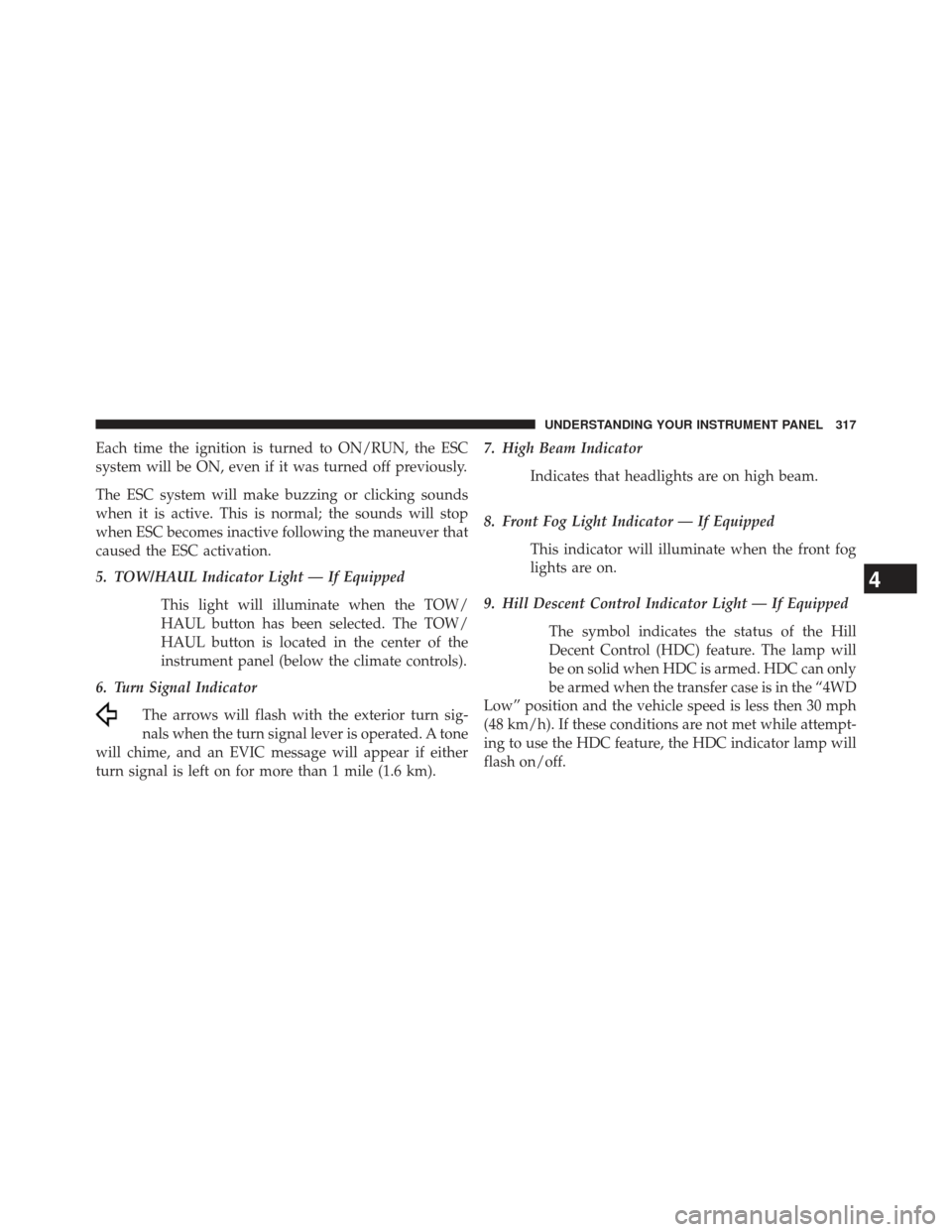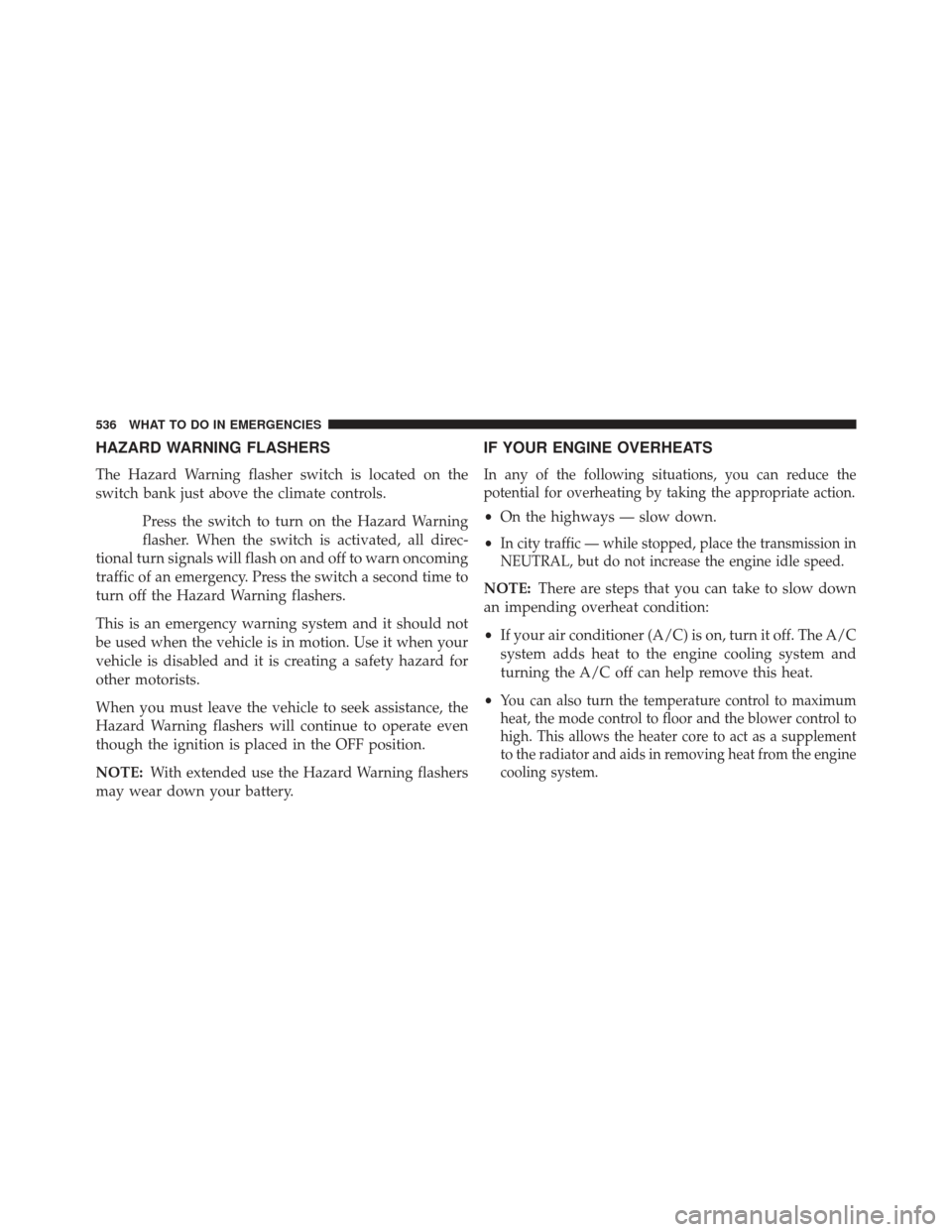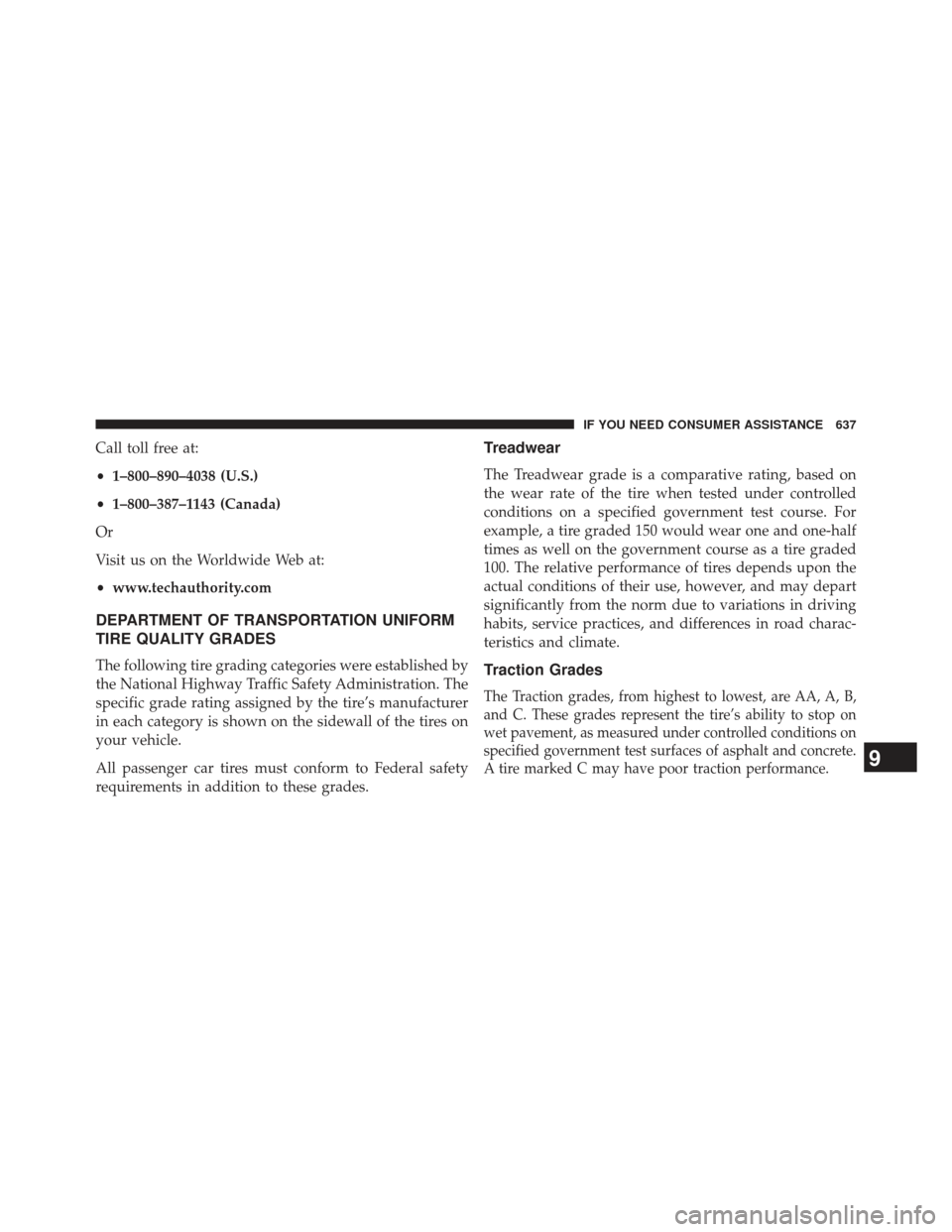Page 315 of 661
INSTRUMENT PANEL FEATURES
1 — Air Outlet6 — Lower Switch Bank11 — Hood Release
2 — Instrument Cluster 7 — Hazard Switch12 — Fuel Door Release
3 — Radio 8 — Storage Bin13 — Headlight Switch
4 — Glove Compartment 9 — ESC Button14 — Dimmer Control
5 — Climate Controls 10 — Ignition Switch
4
UNDERSTANDING YOUR INSTRUMENT PANEL 313
Page 319 of 661

Each time the ignition is turned to ON/RUN, the ESC
system will be ON, even if it was turned off previously.
The ESC system will make buzzing or clicking sounds
when it is active. This is normal; the sounds will stop
when ESC becomes inactive following the maneuver that
caused the ESC activation.
5. TOW/HAUL Indicator Light — If EquippedThis light will illuminate when the TOW/
HAUL button has been selected. The TOW/
HAUL button is located in the center of the
instrument panel (below the climate controls).
6. Turn Signal Indicator
The arrows will flash with the exterior turn sig-
nals when the turn signal lever is operated. A tone
will chime, and an EVIC message will appear if either
turn signal is left on for more than 1 mile (1.6 km). 7. High Beam Indicator
Indicates that headlights are on high beam.
8. Front Fog Light Indicator — If Equipped This indicator will illuminate when the front fog
lights are on.
9. Hill Descent Control Indicator Light — If Equipped The symbol indicates the status of the Hill
Decent Control (HDC) feature. The lamp will
be on solid when HDC is armed. HDC can only
be armed when the transfer case is in the “4WD
Low” position and the vehicle speed is less then 30 mph
(48 km/h). If these conditions are not met while attempt-
ing to use the HDC feature, the HDC indicator lamp will
flash on/off.
4
UNDERSTANDING YOUR INSTRUMENT PANEL 317
Page 436 of 661
CLIMATE CONTROLS
The air conditioning and heating system is designed to
make you comfortable in all types of weather.
Dual-Zone Automatic Temperature Control
(ATC) — If Equipped
•The Automatic Temperature Control (ATC) allows
both driver and front passenger seat occupants to
select individual comfort settings.
• When occupants in the vehicle select an Auto mode
operation, Auto blower operation is set by using a
push button on the control unit and a comfort tem-
perature setting by using the temperature up and
down buttons.
• The system provides set-and-forget operation for op-
timum comfort and convenience.
• The system can be controlled manually, if desired. The ATC system automatically maintains the interior
comfort level desired by the driver and passenger.
Automatic Temperature Control (ATC) Panel
434 UNDERSTANDING YOUR INSTRUMENT PANEL
Page 438 of 661

9. Passenger Temperature Control Down Button
Provides the passenger with independent temperature
control. Push the button for cooler temperature settings.
10. Auto Temperature Control Button
Controls airflow temperature, distribution, volume, and
the amount of air recirculation automatically. Press and
release to select. Refer to “Automatic Operation” for
more information. Performing this function will cause
the ATC to switch between manual mode and automatic
modes.
11. Blower Control
There are seven blower speeds, the blower speed in-
creases as you move the control to the right from the
lowest blower setting. Performing this function will
cause the ATC to switch into manual mode.
12. Climate Control ON/OFF Button
Press and release this button to turn the Climate Control
OFF
13. Mode Control Button
Press and release to select between Modes (Panel, Bi-
Level, Floor, Mix). Performing this function will cause the
ATC to switch into manual mode.
14. SYNC Button
Press and release to control the temperature setting for
both zones from the driver temperature control.
15. Driver Temperature Control Down Button
Provides the driver with independent temperature con-
trol. Push the button for cooler temperature settings.
436 UNDERSTANDING YOUR INSTRUMENT PANEL
Page 538 of 661

HAZARD WARNING FLASHERS
The Hazard Warning flasher switch is located on the
switch bank just above the climate controls.Press the switch to turn on the Hazard Warning
flasher. When the switch is activated, all direc-
tional turn signals will flash on and off to warn oncoming
traffic of an emergency. Press the switch a second time to
turn off the Hazard Warning flashers.
This is an emergency warning system and it should not
be used when the vehicle is in motion. Use it when your
vehicle is disabled and it is creating a safety hazard for
other motorists.
When you must leave the vehicle to seek assistance, the
Hazard Warning flashers will continue to operate even
though the ignition is placed in the OFF position.
NOTE: With extended use the Hazard Warning flashers
may wear down your battery.
IF YOUR ENGINE OVERHEATS
In any of the following situations, you can reduce the
potential for overheating by taking the appropriate action.
• On the highways — slow down.
•
In city traffic — while stopped, place the transmission in
NEUTRAL, but do not increase the engine idle speed.
NOTE: There are steps that you can take to slow down
an impending overheat condition:
• If your air conditioner (A/C) is on, turn it off. The A/C
system adds heat to the engine cooling system and
turning the A/C off can help remove this heat.
•
You can also turn the temperature control to maximum
heat, the mode control to floor and the blower control to
high. This allows the heater core to act as a supplement
to the radiator and aids in removing heat from the engine
cooling system.
536 WHAT TO DO IN EMERGENCIES
Page 600 of 661
Cavity Car-tridgeFuse Mini
Fuse Description
M11 10 Amp
Red Heating, Ventilation
& Air Conditioning (Climate Control System)
M12 30 Amp
Green Radio/Amplifier
M13 20 Amp
Yellow Instrument Cluster
M14 20 Amp
Yellow Back Up Camera –
If EquippedCavity Car- tridgeFuse Mini
Fuse Description
M15 20 Amp YellowPower Seat
Module(s)/
Adaptive Cruise Control/Audio
Telematics/Daytime Running Lights
Relay/Air Suspen- sion Module/
Instrument Cluster
M16 10 Amp RedOccupant Restraint
Controller
M18 15 Amp BlueStop Lamp
M19 25 Amp
Natural Automatic Shut-
down 1 and 2
598 MAINTAINING YOUR VEHICLE
Page 602 of 661
Cavity Car-tridgeFuse Mini
Fuse Description
M31 20 Amp YellowBackup Lamps
M32 10 Amp RedOccupant Restraint
Controller
M33 10 Amp RedPowertrain
Controller/
Transmission Controller
M34 10 Amp RedPark Assist
Module/Climate Control System
Module/Infra Red Sensor/Compass ModuleCavity Car- tridgeFuse Mini
Fuse Description
M35 15 Amp BlueLeft Rear Parklamps
M36 20 Amp
Yellow Power Outlet
M37 10 Amp
Red Antilock Brakes/
Stability Control System Module
M38 25 Amp
Natural All Door Lock &
Unlock
600 MAINTAINING YOUR VEHICLE
Page 639 of 661

Call toll free at:
•1–800–890–4038 (U.S.)
• 1–800–387–1143 (Canada)
Or
Visit us on the Worldwide Web at:
• www.techauthority.com
DEPARTMENT OF TRANSPORTATION UNIFORM
TIRE QUALITY GRADES
The following tire grading categories were established by
the National Highway Traffic Safety Administration. The
specific grade rating assigned by the tire’s manufacturer
in each category is shown on the sidewall of the tires on
your vehicle.
All passenger car tires must conform to Federal safety
requirements in addition to these grades.
Treadwear
The Treadwear grade is a comparative rating, based on
the wear rate of the tire when tested under controlled
conditions on a specified government test course. For
example, a tire graded 150 would wear one and one-half
times as well on the government course as a tire graded
100. The relative performance of tires depends upon the
actual conditions of their use, however, and may depart
significantly from the norm due to variations in driving
habits, service practices, and differences in road charac-
teristics and climate.
Traction Grades
The Traction grades, from highest to lowest, are AA, A, B,
and C. These grades represent the tire’s ability to stop on
wet pavement, as measured under controlled conditions on
specified government test surfaces of asphalt and concrete.
A tire marked C may have poor traction performance.
9
IF YOU NEED CONSUMER ASSISTANCE 637